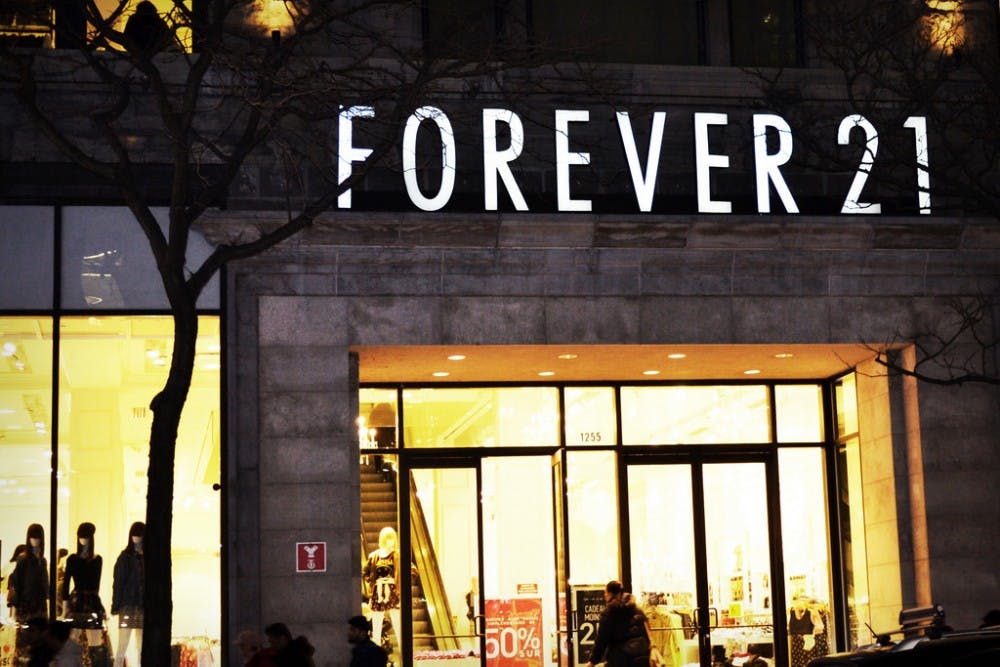Every second, the equivalent of one garbage truck of textiles is either burned or dumped into a landfill, with an estimated lost value of $500 billion per year. And at what cost? The industry is plagued with dangerous working conditions, as exemplified by the 2013 collapse of a Bangladesh garment factory, which killed 1134 workers and injured about 2500 more. It’s also harmful to the environment, with textile production emitting 1.2 billion tons of greenhouse gases annually.
With the negatives so glaring, why don’t college students cut back on their fast fashion intake?
To be frank, it’s because we’re broke. For the majority of college students, one look at most ethical and sustainable brands’ price tags sends them reeling (and for good reason). It was certainly the case for me. The top search result for “cheap ethical clothing” is an article that lists brands whose prices reach $300. With brands like Forever 21 selling far trendier clothes for less than $20 (or sometimes even $10) and tuition bills looming, it seems like the choice is made for us.
This problem can be twofold if you are plus-sized or an unusual height. Most ethical brands only make straightforward clothes for what they see as the “usual” customer. Plus-sized clothes are limited or non-existent, and if you’re 5 feet 11 inches tall (like me) or taller, it’s endlessly frustrating to find pants, dresses or skirts that don’t look too short.
These constant setbacks present an obvious question: Is it even worth it? Will multi-billion dollar fast fashion corporations really suffer because I don’t buy a few new shirts this season?
That’s the wrong way to look at it. As an ethical shopper, your money is not being spent with the intent to cripple big brands. Instead, every dollar you put toward ethical clothing is a vote, keeping quality brands out of the red, helping workers in ethical factories keep their jobs and showing big businesses that there really is a market for sustainability.
But that still raises the question: What is a well-meaning but broke college student to do?
One, set your own standards. Shopping more ethically and sustainably looks different for every buyer. Maybe you can’t afford to go cold turkey. Maybe you can only afford to buy brands that simply “aren’t the worst” rather than “the best.” Maybe there are no even remotely sustainable stores within 50 miles of your hometown. Shopping ethically, like any attempt at change, means making sacrifices. But not everyone is able to make the same ones, especially lower-income students. For most of us, compromises will be inevitable. Don’t focus on that. Instead, do your best to strike a good ratio and do what you can.
Two, buy clothes “made in the USA.” “Made in the USA” is usually shorthand for “the person who made me was paid at least a minimum wage and environmental constraints were put on the producers.” It’s often cheaper to look at a fast fashion brand’s “Made in the USA” section online than to buy from entirely sustainable brands. Although it’s not ideal, it does send a firm message to the brands that there is a market for such pieces. The same goes for brands with ethically-made lines.
Three, buy second-hand from vintage, consignment or thrift shops. Over the past few years, thrifting has become more “trendy.” While this unfortunately means that most thrift stores have upped their prices a few dollars, it also means that more curated second-hand stores are popping up and that the entire experience is becoming less stigmatized. It is undeniable that shopping secondhand is one of the best ways to cut down on fast fashion, minimizing the amount of new pieces that need to be bought and limiting the waste that comes from throwing last season’s purchases into the garbage. You can also use second-hand apps like Depop or Poshmark, which allow people buy clothes directly from the previous owner.
Four, invest in a needle and thread. Don’t throw out old fast fashion pieces just because they have a tear. Landfills are already filled to the brim with cheap clothes, and that cute graphic tee doesn’t need to join them just yet. By taking the initiative to fix pieces rather than tossing them, you’ll also be able to save money by buying fewer clothes.
And five, save up. At the end of the day, it’s a better investment to save up for an ethical, sustainable, well-made piece of clothing that will last you years (or even decades) than to impulsively buy a cheap piece that will last a season.
Living ethically and sustainably on a budget isn’t easy, or even always possible. But if you have the means to, then making sure your clothes weren’t sewn by a child earning cents a day in a factory poisoning the planet is the least you can do.
Claire Goudreau is a freshman from New Jersey.

















